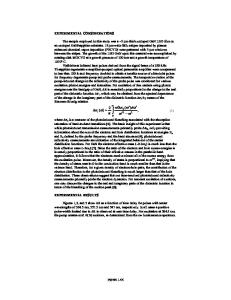The Study of Seam Line Defects in Silicon-on-Oxide by Merged Epitaxial Lateral Overgrowth
- PDF / 1,744,194 Bytes
- 6 Pages / 414.72 x 648 pts Page_size
- 74 Downloads / 367 Views
techniques to control these defects so as to improve epitaxial film quality, are important subjects which must be investigated before high performance devices on SOI can be realized. EXPERIMENTAL The substrates used for the selective epitaxial growth were P-type (100) Si wafers with resistivity of 30-50 fU-cm. Thermal oxide layers of 0.5 gm thickness were grown at 1000 0 C. Conventional lithography was used to define the bare silicon and oxide-covered regions. Pattern features were aligned along as well as the directions. Plasma-etching was used to etch the oxide and open seed window regions with vertical sidewalls. To eliminate any surface damage induced by plasma-etching, a 100A sacrificial oxide layer was grown and etched away by dilute HF soultion during the pre-epi cleaning[9]. The pre-epitaxial wafer cleaning procedure consists of two H 2 SO 4 -H 2 0 2 (Piranha) treatments with an intermediate dilute HF dip that removes the sacrificial oxide. A 5-sec. HF vapor( 1:2 H20:49% HF ) exposure was performed right before loading to remove the chemical oxide and passivate the bare Si surface[10]. A hotwall low pressure chemical vapor deposition (LPCVD) reactor using SiH 2 C12/H 2 gas mixture was used to perform the epitaxial growth. The wafers were loaded into the reactor at 525'C, then ramped up to 900'C for a 15 min prebake in a 6 Torr H2 ambient. They then were ramped downwards to the deposition temperature of 850'C. Silicon deposition was carried out in a mixture of 7.4% DCS (SiH 2 C12 ) in H2 at 0.55 Torr. A 0.025% low flow rate of DCS was added during the prebake and the ramp-down steps for the purpose of reducing the moisture content of the system[ 11]. ELO over oxide strips along directions has smooth growth fronts and sharp (110) facet planes. In the case of ELO over oxide along directions, irregular growth fronts and multiple facet planes were formed. Big voids above the center of the oxide were observed with irregular merging planes[12,13]. As illustrated by Arst et.al., SOI made by Merged ELO on oxide along directions is expected to be highly defective and has a complicated "Seam plane" which could hardly be improved due to the existance of dislocation enhancing mechanisms by {1111 slip planes intersecting the < 110> oxide sidewall edges. To simplify the investigation, only ELO on oxide strips along directions will be considered at this point. RESULTS Fig. 1 is a Nomarski optical micrograph showing the surface morphology of a 2.5gim thick selective epitaxial layer. In this picture, the narrower oxide strips are totally buried by epitaxial silicon while the wide oxide strips are only partially overgrown. The exposed oxide regions are free of nucleation which shows that an excellent selectivity has been achieved. In the cross-sectional TEM image (Fig. 2), characteristic dark lines illustrate that unique crystallographic defects are formed at the interfaces where two growth fronts from opposite sides of oxide strips merge. These "seam"-like defects can be made invisible under various electron diffraction cond
Data Loading...











